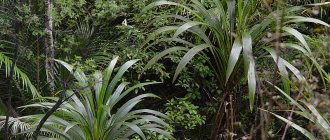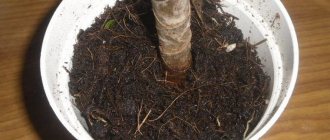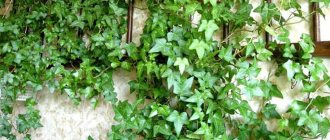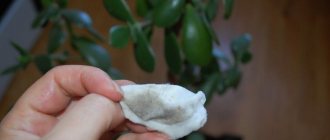Cordyline, a plant that resembles dracaena in its appearance, but has nothing to do with it. It belongs to the agave family. These are shrubs and trees with an evergreen crown. About 15 species are mainly common in culture.
Under natural conditions, these are mostly large trees, reaching several meters in height. At home, cordyline is a slow-growing long-liver, but only with proper care and sufficient lighting and space for growth. Large specimens are planted in tubs and placed in a well-lit place, for example, near a window. A thin curtain will protect the plant from direct sunlight, but in the shade the cordyline begins to lose foliage and does not look attractive. Cordyline is usually sold in the form of a rooted piece of stem.
The most common types of Cordyline are as follows: Southern Cordyline or Australian Cordyline is a tree with saber-shaped narrow green leaves; there are varieties with red or yellow stripes. This is the most unpretentious species, its homeland is South Zealand.
Cordyline care
The temperature at which Cordyline is kept must be at least 15 °C. Overwintering for almost all species is preferable in a cool place from 8 to 10 ° C.
It is advisable to place the pot with the plant in a bright or slightly shaded place; direct sunlight is harmful to it. Some people mistakenly compare cordelina and dracaena, but cordelina is not a shade-loving plant; it stops growing in the shade, so good lighting is necessary for a beautiful, well-growing plant. Moreover, lighting is more important for variegated forms than for green-leaved forms, because in the shade they lose their variegated color.
Watering
Cordyline is watered abundantly in summer and moderately in winter. When there is overflow and stagnation of water, the plant begins to lose foliage, but drying out the soil is also harmful. Watering through a tray is good for them. It is advisable to fertilize during the period of active growth, from April until approximately the beginning of autumn, once every 2 weeks. Regular spraying has a beneficial effect on plant growth. While the plant is not large, a tray with water would be a good solution for it. Sometimes the Cordyline can be given a warm shower to wash off the dust and freshen up. In winter, dry air may cause the tips of the plant's leaves to turn brown.
Interesting Facts
- Literally translated, the word "Dracena" means "female dragon." The second most popular name for the plant is dragon tree.
- According to some beliefs, dracaena grew at the burial site of the last dragon on earth (hence the name). It is believed that the juice of the plant has a miraculous effect and can heal many diseases.
- According to Indian legend, dracaena grew from an ordinary stick stuck in the ground. The leader of the Indians promised the warrior in love with his daughter to give consent to the marriage only if leaves appeared from the stick. This is what happened on the fifth day. This is where the belief was born - a cut piece of a wooden dracaena trunk brings good luck in love.
- Since ancient times, dracaena juice has had special properties - a resin that quickly hardens in air. They say that the famous Stradivarius used this resin to process his violins. The master believed that the special resonance of his musical instruments was precisely the merit of this resin.
- The ancient Indians used the bark of the tree to make shields. The juice of the plant was previously used as an antiseptic in India. And in Spain, wood was actively used in shipbuilding.
- The largest known dracaena grew on the island of Tenerife. In 1975, it reached 14 meters in trunk circumference, and its age at that time was, according to various sources, from 250 to 365 years!
Indoor flower dracaena, varieties with photos and names
The indoor dracaena flower is a perennial plant that belongs to the agave family. Outwardly it resembles a palm tree. This type of plant is very common in Africa, Asia and the Canary Islands.
Some varieties and types of dracaena are used for making brushes and extracting resin. Growing these plants at home is not particularly difficult, so they are often used to decorate interiors.
Photos of dracaena varieties in pots
Currently, approximately 150 species and varieties of dracaena are known. Approximately 40 of them can be grown at home. Let's see what dracaena looks like. Photos and names of the most common varieties of this indoor flower are presented below.
Dracaena Dragon or Dragon Tree (Dracaena draco)
There are bright red spots on the stem that are formed from the seeping juice. This branched tree can reach a height of 10 m. The leaves are sword-shaped.
Dracaena fragrans
It has bright green leaves with a gray stripe running down the center. With proper care, it begins to bloom with small but fragrant flowers.
Dracaena godseffiana
White spots stand out brightly on the green oval leaves. The flowers of this type of dracaena are yellow-green with a delicate, pleasant aroma.
Dracaena Sanderiana
Most often, the leaves are slightly twisted and have a gray-green color. It can reach up to 100 cm in height and has a fairly thin trunk.
Dracaena Deremensis
Dracaena Reflexa or Reflexa
Dracaena Compacta
Dracaena Lemon Lime
Dracaena flower - types and features of care
One ancient Aztec legend tells of a warrior who fell in love with the daughter of a chieftain. When asked to give her as a wife, the father replied that this would happen if a stick stuck in the ground became covered with leaves. The warrior watered the stick, and on the fifth day leaves appeared on it, and then a tree grew - dracaena. Soon the hero of the legend married the leader’s daughter, and the dracaena was called the tree of happiness. Today, this palm-like plant can be found in many homes and offices. With proper care, dracaena can indeed be grown from a stem stuck into the ground and watered abundantly.
Plant characteristics
Dracaena is a plant that lives in Africa, South Asia and tropical Central America. Young dracaena looks like a bush. With age, its trunk becomes bare and becomes woody. In some species, the leaves are collected in a bunch at the top of the stem, making the flower look like a palm tree. But you can find dracaenas whose leaves are arranged spirally or whorled. With good care, dracaena can live 15 years. It grows slowly and hardly blooms at home. Dracaena leaves can reach 70 cm in length, but regardless of age, the flower almost always looks great.
Varieties
According to various sources, there are from 40 to 300 species of dracaena. They can be found in residential buildings, in halls and lobbies of hotels, offices, winter gardens, and as part of landscape compositions.
In rooms with high ceilings it is quite possible to grow edged dracaena. This plant resembles a palm tree and has narrow, long leaves at the top of the trunk, which, when dropped, form a characteristic pattern on the trunk. This species reaches 3 meters in height.
At home, Dracaena derema is more common. It has large leaves with white stripes.
Many people prefer the dracaena sandera flower. It resembles bamboo. This look can be given the effect of a spiral trunk.
Dracaena fragrant is decorated with white fragrant inflorescences. Moreover, buds appear even at low temperatures.
The Dracaena reflexum flower has a stem covered with leaves from the base to the top. The leaves have a golden edge.
Dracaena 'godsepha' has oval leaves and is bush-like. Its main feature is white and golden inclusions on the surface of the leaves.
Dracaena "draco" is a bush called false palm. In wild conditions it can grow up to 25 m, and in domestic conditions - only up to 1.5 m. This flower is distinguished by a straight trunk and sword-shaped leaves with a red frame.
Light
The dracaena flower will feel comfortable near a south or west window. Direct rays can cause burns and contact with them is undesirable, but diffused light should be intense. Dracaenas with variegated leaves need more light and warmth, plants with green leaves need less. Avoid partial shade.
Temperature
The dracaena flower prefers moderate temperatures. In summer it should not be higher than +25 °C, in winter – not lower than +12 °C. A draft is undesirable, so it is better not to leave dracaena under an open window.
Humidity
Dry air is not a problem for dracaena, but it is still worth creating a humidified microclimate so that moisture does not stagnate on the leaves. The flower will feel better if it is irrigated from time to time with a sprayer or the leaves are wiped with a damp cloth. In summer and during the heating season, spray more often.
Watering
The dracaena flower prefers regular and abundant watering. The procedure should be carried out when the soil layer has dried out by 2–3 cm. The roots should not be waterlogged, otherwise the plant may get sick. Always loosen the top layer of soil first, then moisten it with filtered or settled water.
In summer, watering is necessary every 2-3 days. If the leaves dry out, then more often. In winter, reduce watering to once a week, but if the pot is near a heater, moisten the soil as it dries to prevent the flower from drying out.
Trimming
As the plant ages, it loses its decorative properties. So, for example, you can get a long bare trunk almost 2-3 meters high with a tuft of leaves at the top. To give the dracaena flower the correct shape, it needs to be trimmed. A new false palm will grow from the stem, and a second plant can be produced from the top.
To prune, do air layering. Below the top, make a T-shaped cut. Place wet peat there, cover it with tightly wound polyethylene, and in a month you will get new roots. Once this happens, cut off the top below the new roots and transfer to another pot.
If you don’t have time to wait for air layering to take root, cut the top to the length you need with a sterile knife. Sprinkle the cut with activated carbon and then with Zircon. Remove the lower leaves from the trunk, place the stem in a pot, sprinkled with soil. If the leaves are too heavy, they can be shortened by a third. The stem that remains in the old pot can be sealed with melted paraffin and watered. After a while, as in the old Aztec legend, it will sprout new shoots.
Transfer
Once every 2–3 years, the dracaena flower needs to be transplanted into a new, larger pot. The choice of a new home depends on the height and root system of the plant. A dracaena 50 cm tall needs a pot with a diameter of at least 20 cm. In the future, purchase a pot with a diameter 2 cm larger than the previous one.
A layer of drainage is required at the bottom of the transplant pot. The soil should match the mixture for palm trees. Or you can mix leaf, turf, peat and compost soil in a ratio of 2:4:1:2.
The dracaena flower needs to be replanted every 2–3 years.
Pour boiled water over the pot and fill in the drainage. Then remove the flower from the old pot, cut off any rotten roots, if any, spray the entire root system with a spray bottle. Plant the bush in a new pot and cover it with soil. The soil should also fill the space between the roots. After replanting, the bush needs to be watered with the addition of Zircon fertilizer. In the future, apply fertilizer once a month, with the exception of the period from April to December, when this should be done twice as often, and the winter period, when this should be done half as often. Use universal bait for palm trees and dracaenas.
Reproduction
Dracaena can be propagated by apical layering, seeds and stem pieces. You already know about the first method.
Seed propagation is possible only for varieties with green leaves. Dracaena seeds need to be soaked in a growth stimulator for a day at a temperature of +30 °C. The next step is planting in a greenhouse. Place the seeds in a disposable container with palm soil, place in a warm place and cover with film. Shoots will appear in 1–2 months. When this happens, remove the film and begin watering and fertilizing. A small dracaena 5–6 cm high can be planted in a pot.
For stem cuttings, select a young and strong stem, cut into 3–5 cm pieces so that each has at least two buds. Cut the bark on the stem and bury the cutting with a cut into the ground. Next, cover it with a glass jar and place it in a warm place away from direct sunlight. If it is humid enough under the jar, shoots will appear in 1–1.5 months. They will need to be sprayed from time to time.
Diseases
The main enemies of dracaena are drafts and cold. Because of this, many plants do not survive the winter. During the cold season, do not place the bush on the windowsill. Do not overdo it with fertilizers and watering: the plant needs rest at this time. If the water in the ground begins to harden, the roots will become too cold, the plant will freeze, and when the roots begin to rot, the leaves will turn yellow and fall off. At an early stage, you can save the situation by moving the dracaena bush away from the cold window and protecting it from drafts. Dracaena will need to be revived by watering and spraying. Dried leaves will have to be cut off. If not only the leaves, but also the trunk are damaged, remove all soft spots from it, and water the rest in winter mode. In the spring, the plant affected by rotting will need to be replanted.
The leaves of the dracaena flower can dry out from direct sunlight, in which case you need to move the pot to a safe place. Finally, like any other plant, dracaena dries from lack of moisture. Spray it more often. If the leaves have already turned yellow and fallen off, cut off and root the top of the plant.
Dracaena also has enemies among insects. As a rule, this is a spider mite, which makes itself felt with yellow spots and cobwebs between the leaves, as well as a scale insect, due to which brown plaques appear at the bottom of the leaf. If you frequently spray, wipe and care for the plant, pests will not appear. Those that have already settled in the pot can be expelled with an insecticide.
All these methods of caring for and propagating dracaena are simple and do not require special knowledge. It is usually sufficient to regularly water, spray, fertilize and replant the plant in accordance with its life cycles. And you will get an excellent result in the form of a juicy, green and healthy bush.
Rate this article:
4.63 out of 5 (Ratings:
Similar articles
domskotom.net











